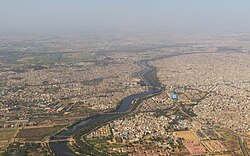| Najafgarh Drain River Sahibi (Northernmost end) | |
|---|---|
 Aerial view | |
 | |
| Location | |
| Country | India |
| City | Delhi |
| Physical characteristics | |
| Mouth | Yamuna River |
• location | Delhi, India |
| Basin features | |
| River system | Yamuna River |
| Landmarks | Najafgarh lake, Najafgarh Drain Bird Sanctuary |
| Pollution status | Highly polluted due to sewage inflow |


The Najafgarh drain or Najafgarh nalah (nalah in Hindi means rivulet or storm water drain), which also acts as Najafgarh drain bird sanctuary, is another name for the northernmost end of River Sahibi, which continues its flow through Delhi, where it is channelized, and then flows into the Yamuna. Within Delhi, due to its channelization for flood control purposes, it is now erroneously called "Najafgarh drain" or "Najafgarh nullah." It gets this name from the once famous and huge Najafgarh Jheel (lake) near the town of Najafgarh in southwest Delhi and within urbanized Delhi. It is the Indian capital’s most polluted water body due to direct inflow of untreated sewage from surrounding populated areas. A January 2005 report by the Central Pollution Control Board classifies this drain, with 13 other highly polluted wetlands, under category ‘‘D’’ for assessing the water quality of wetlands in wildlife habitats.[1][2][3][4][5]
This drain was widened as a flood control drain linking the Najafgarh lake to the river Yamuna, thus completely draining the once huge and ecologically rich Najafgarh Lake, famous for its wetland ecosystem, waterbirds and Wildlife.
- ^ Blot across the Capital: Najafgarh most polluted[dead link], Sunday, 10 July 2005, The Indian Express
- ^ Environment minister raises a stink over Najafgarh jheel[dead link], 22 February 2005, The Indian Express
- ^ Najafgarh basin Delhi’s most polluted area, 25 Dec 2009, The Indian Express
- ^ Najafgarh drain 11th among highly polluted industrial clusters, 25 Dec 2009, The Times of India
- ^ Najafgarh drain causes less pollution in Yamuna now Archived 11 July 2006 at the Wayback Machine, 4 July 2006, The Indian Express